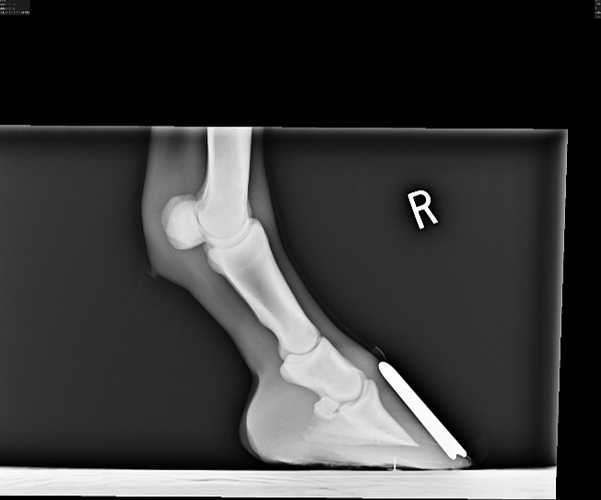When I got Mare earlier this year, I was new to horse ownership in this area and used a farrier who butchered her feet. Like her soles were badly bruised before the farrier was even done. The farrier carved a bunch of sole and toe off and just generally did a horrible job. She was dead lame for a week and has a big event line on all four hooves that correspond roughly to about when this trim happened.
FF to August of this year and Mare was diagnosed with a soft tissue injury during a lameness exam. We took X-rays of her front hooves and the vet said she had thin soles, I can’t remember what the left measured at but she said the right was 0.47 inches thick. Not sure what they should be but the Vet said at least half an inch? Her toes are also long and heels underrun but I knew this going into the lameness exam.
Anyway, since Mare is only 3.5 I do not want to shoe her yet. I have moved her to a new barn and she has an excellent farrier now. She lives outside 24/7 and I hand walk her on trails ~3 times a week that have 0.75 to 1.5 miles of gravel paths on them. I make her walk on the gravel even though she takes ouchy steps sometimes because Pete Ramey et al say that walking on gravel is a way to build their soles up. She’s been on Cal Trace Plus for most of this year. I put iodine on her soles 2-3 times a week and Keratex hoof hardener on her hoof walls once a week.
Is there anything else I can be doing to help her feet out? I cringe when I see her take an ouchy step on the gravel even if it does help her in the long run (right  ?) Her new farrier is really great and she is on a 5 week cycle, I have her diet and topical applications covered, we do lots of walking within the realm of what’s appropriate with her injury. Is it just a waiting game? She is going to be out of work until likely April or May and will have a full lameness work up before I put her back in a program.
?) Her new farrier is really great and she is on a 5 week cycle, I have her diet and topical applications covered, we do lots of walking within the realm of what’s appropriate with her injury. Is it just a waiting game? She is going to be out of work until likely April or May and will have a full lameness work up before I put her back in a program.



